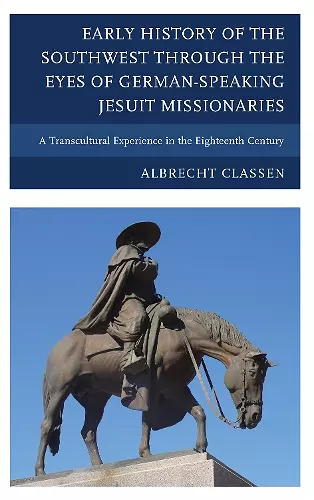Early History of the Southwest through the Eyes of German-Speaking Jesuit Missionaries
A Transcultural Experience in the Eighteenth Century
Format:Hardback
Publisher:Lexington Books
Published:13th Dec '12
Currently unavailable, and unfortunately no date known when it will be back

The history of the United States has been deeply determined by Germans throughout time, but hardly anyone has noticed that this was the case in the Southwest as well, known as Arizona/Sonora today, in the eighteenth century as Pimería Alta. This was the area where the Jesuits operated all by themselves, and many of them, at least since the 1730s, originated from the Holy Roman Empire, hence were identified as Germans (including Swiss, Austrians, Bohemians, Croats, Alsatians, and Poles). Most of them were highly devout and dedicated, hard working and very intelligent people, achieving wonders in terms of settling the native population, teaching and converting them to Christianity. However, because of complex political processes and the effects of the ‘black legend’ all Jesuit missionaries were expelled from the Americas in 1767, and the order was banned globally in 1773. As this book illustrates, a surprisingly large number of these German Jesuits composed extensive reports and even encyclopedias, not to forget letters, about the Sonoran Desert and its people. Much of what we know about that world derives from their writing, which proves to be fascinating, lively, and highly informative reading material.
Who would have thought that the early history of Sonora and Arizona was so deeply influenced by the arrival and long-term presence of German-speaking Jesuit missionaries during the 18th century? Prof. Classen offers a highly engaging study of these brave and intelligent men who had dedicated their adult lives to missionary activities in that semi-arid desert and who wrote extensive reports and sometimes maintained a large correspondence (Segesser) with their families back home. On the basis of those documents (in German!) Prof. Classen gives us a most vivid picture of how these European missionaries confronted the New World, how they coped in the cacti-filled desert, and how they reached out to the native population. This book truly opens a new chapter in the history of the Southwest, demonstrating, from an unexpected perspective, the deep impact of German speakers on 18th-c. Sonora. -- Ronald G. Murphy, Georgetown University
This book deals with the history of Jesuit missionary activities in the Sonoran Desert region of Spain’s New World territory, an area that today lies partly in northern Mexico and partly in southern Arizona. These missionaries arrived there by the late seventeenth century and, under the leadership of Father Eusebio Kino, quickly established a large network of missions that soon became the foundation for all future settlements. Many of the subsequent missionaries originated from German-speaking lands and made great efforts to reflect upon their experiences and observations. They left behind excellent maps and highly detailed reports, some of which were even encyclopedic in scope. The history of these German Jesuits came to a sudden halt in 1767 when they were all ordered to leave the Americas, and in 1773 when the entire Jesuit order was banned globally—certainly a tragic development resulting from global tensions and mistrust of the Jesuit Order. The missionaries, if they survived the long journey back home, continued to write about the world they had left behind and provided their audiences with impressive accounts that shed important light on the world of northern Mexico and southern Arizona. -- Marilyn L. Sandidge, Westfield State University
The Jesuit missionaries in Arizona and Mexico in the early modern age created singular cultural bridges between Europe and America with their scientific and literary accomplishments. With ethnological and scientific studies and through their extensive work as architects, composers, and writers they laid the foundation for the Christianizing in the New World, and they contributed to the considerable expansion of knowledge about that continent back in their countries of origin. Their work was based on multifarious exchange and communication; nevertheless, after the Jesuits’ expulsion in 1767 the indigenous culture and their representatives were most severely suppressed in the 19th century. Albrecht Classen presents here through the careful analysis of a wide range of primary sources the cultural and historical background. -- Markus Ries, University of Lucerne, Switzerland
[A]uthor Albrecht Classen provides a good encyclopedic compendium of these missionaries and their texts. * Western Historical Quarterly *
Classen includes in this overview an interesting summary of Joseph Stoecklein’s Welt-Bolt, a collection of missionary reports from different Jesuit mission fields that were translated into German. * The Catholic Historical Review *
ISBN: 9780739177846
Dimensions: 236mm x 159mm x 23mm
Weight: 467g
228 pages